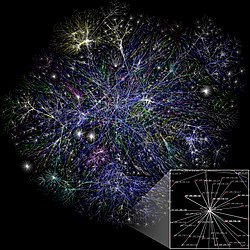Computer network
This article needs additional citations for verification. (June 2023) |
| Part of a series on | ||||
| Network science | ||||
|---|---|---|---|---|
| Network types | ||||
|
||||
| Graphs | ||||
|
||||
| Models | ||||
|
||||
| ||||
| Operating systems |
|---|
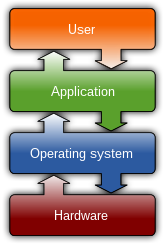 |
| Common features |
A computer network is a set of
The nodes of a computer network can include personal computers, servers, networking hardware, or other specialized or general-purpose hosts. They are identified by network addresses and may have hostnames. Hostnames serve as memorable labels for the nodes and are rarely changed after initial assignment. Network addresses serve for locating and identifying the nodes by communication protocols such as the Internet Protocol.
Computer networks may be classified by many criteria, including the
Computer networks support many applications and services, such as access to the World Wide Web, digital video and audio, shared use of application and storage servers, printers and fax machines, and use of email and instant messaging applications.
History
Computer networking may be considered a branch of computer science, computer engineering, and telecommunications, since it relies on the theoretical and practical application of the related disciplines. Computer networking was influenced by a wide array of technological developments and historical milestones.
- In the late 1950s, a network of computers was built for the U.S. military Semi-Automatic Ground Environment (SAGE) radar system[1][2][3] using the Bell 101 modem. It was the first commercial modem for computers, released by AT&T Corporation in 1958. The modem allowed digital data to be transmitted over regular unconditioned telephone lines at a speed of 110 bits per second (bit/s).
- In 1959, Christopher Strachey filed a patent application for time-sharing and John McCarthy initiated the first project to implement time-sharing of user programs at MIT.[4][5][6][7] Strachey passed the concept on to J. C. R. Licklider at the inaugural UNESCO Information Processing Conference in Paris that year.[8] McCarthy was instrumental in the creation of three of the earliest time-sharing systems (the Compatible Time-Sharing System in 1961, the BBN Time-Sharing System in 1962, and the Dartmouth Time Sharing System in 1963).
- In 1959, Anatoly Kitov proposed to the Central Committee of the Communist Party of the Soviet Union a detailed plan for the re-organization of the control of the Soviet armed forces and of the Soviet economy on the basis of a network of computing centers.[9] Kitov's proposal was rejected, as later was the 1962 OGAS economy management network project.[10]
- In 1960, the commercial airline reservation system semi-automatic business research environment (SABRE) went online with two connected mainframes.
- In 1963, J. C. R. Licklider sent a memorandum to office colleagues discussing the concept of the "Intergalactic Computer Network", a computer network intended to allow general communications among computer users.
- Throughout the 1960s,
- In 1965, telephone switchthat implemented computer control in the switching fabric.
- In 1969, the first four nodes of the ARPANET were connected using 50 kbit/s circuits between the University of California at Los Angeles, the Stanford Research Institute, the University of California at Santa Barbara, and the University of Utah.[17] In the early 1970s, Leonard Kleinrock carried out mathematical work to model the performance of packet-switched networks, which underpinned the development of the ARPANET.[18][19] His theoretical work on hierarchical routing in the late 1970s with student Farouk Kamoun remains critical to the operation of the Internet today.
- In 1972, commercial services were first deployed on public data networks in Europe,[20][21][22] which began using X.25 in the late 1970s and spread across the globe.[14] The underlying infrastructure was used for expanding TCP/IP networks in the 1980s.[23]
- In 1973, the French CYCLADES network, directed by Louis Pouzin was the first to make the hosts responsible for the reliable delivery of data, rather than this being a centralized service of the network itself.[24]
- In 1973, Peter Kirstein put internetworking into practice at University College London (UCL), connecting the ARPANET to British academic networks, the first international heterogeneous computer network.[25][26]
- In 1973, Xerox PARC describing Ethernet, a networking system that was based on the Aloha network, developed in the 1960s by Norman Abramson and colleagues at the University of Hawaii. In July 1976, Robert Metcalfe and David Boggs published their paper "Ethernet: Distributed Packet Switching for Local Computer Networks"[27]and collaborated on several patents received in 1977 and 1978.
- In 1974,
- In 1976, John Murphy of Datapoint Corporation created ARCNET, a token-passing network first used to share storage devices.
- In 1977, the first long-distance fiber network was deployed by GTE in Long Beach, California.
- In 1977, Xerox Network Systems (XNS) was developed by Robert Metcalfe and Yogen Dalal at Xerox.[29]
- In 1979, Robert Metcalfe pursued making Ethernet an open standard.[30]
- In 1980, Ethernet was upgraded from the original 2.94 Mbit/s protocol to the 10 Mbit/s protocol, which was developed by Ron Crane, Bob Garner, Roy Ogus,[31] and Yogen Dalal.[32]
- In 1995, the transmission speed capacity for Ethernet increased from 10 Mbit/s to 100 Mbit/s. By 1998, Ethernet supported transmission speeds of 1 Gbit/s. Subsequently, higher speeds of up to 400 Gbit/s were added (as of 2018[update]). The scaling of Ethernet has been a contributing factor to its continued use.[30]
Use
Computer networks extend interpersonal communications by electronic means with various technologies, such as email, instant messaging, online chat, voice and video telephone calls, and video conferencing. A network allows sharing of network and computing resources. Users may access and use resources provided by devices on the network, such as printing a document on a shared network printer or use of a shared storage device. A network allows sharing of files, data, and other types of information giving authorized users the ability to access information stored on other computers on the network. Distributed computing uses computing resources across a network to accomplish tasks.
Network packet

Most modern computer networks use protocols based on packet-mode transmission. A
Packets consist of two types of data: control information and user data (payload). The control information provides data the network needs to deliver the user data, for example, source and destination
With packets, the bandwidth of the transmission medium can be better shared among users than if the network were circuit switched. When one user is not sending packets, the link can be filled with packets from other users, and so the cost can be shared, with relatively little interference, provided the link is not overused. Often the route a packet needs to take through a network is not immediately available. In that case, the packet is queued and waits until a link is free.
The physical link technologies of packet networks typically limit the size of packets to a certain maximum transmission unit (MTU). A longer message may be fragmented before it is transferred and once the packets arrive, they are reassembled to construct the original message.
Network topology

The physical or geographic locations of network nodes and links generally have relatively little effect on a network, but the topology of interconnections of a network can significantly affect its throughput and reliability. With many technologies, such as bus or star networks, a single failure can cause the network to fail entirely. In general, the more interconnections there are, the more robust the network is; but the more expensive it is to install. Therefore, most network diagrams are arranged by their network topology which is the map of logical interconnections of network hosts.
Common topologies are:
- Bus network: all nodes are connected to a common medium along this medium. This was the layout used in the original Ethernet, called 10BASE5 and 10BASE2. This is still a common topology on the data link layer, although modern physical layer variants use point-to-point links instead, forming a star or a tree.
- switched Ethernet LAN, where each client connects to a central network switch, and logically in a wireless LAN, where each wireless client associates with the central wireless access point.
- Token ring networks, and the Fiber Distributed Data Interface(FDDI), made use of such a topology.
- Mesh network: each node is connected to an arbitrary number of neighbors in such a way that there is at least one traversal from any node to any other.
- Fully connected network: each node is connected to every other node in the network.
- Tree network: nodes are arranged hierarchically. This is the natural topology for a larger Ethernet network with multiple switches and without redundant meshing.
The physical layout of the nodes in a network may not necessarily reflect the network topology. As an example, with
Overlay network

An overlay network is a virtual network that is built on top of another network. Nodes in the overlay network are connected by virtual or logical links. Each link corresponds to a path, perhaps through many physical links, in the underlying network. The topology of the overlay network may (and often does) differ from that of the underlying one. For example, many peer-to-peer networks are overlay networks. They are organized as nodes of a virtual system of links that run on top of the Internet.[33]
Overlay networks have been around since the invention of networking when computer systems were connected over telephone lines using modems before any data network existed.
The most striking example of an overlay network is the Internet itself. The Internet itself was initially built as an overlay on the telephone network.[33] Even today, each Internet node can communicate with virtually any other through an underlying mesh of sub-networks of wildly different topologies and technologies. Address resolution and routing are the means that allow mapping of a fully connected IP overlay network to its underlying network.
Another example of an overlay network is a distributed hash table, which maps keys to nodes in the network. In this case, the underlying network is an IP network, and the overlay network is a table (actually a map) indexed by keys.
Overlay networks have also been proposed as a way to improve Internet routing, such as through
For example, Akamai Technologies manages an overlay network that provides reliable, efficient content delivery (a kind of multicast). Academic research includes end system multicast,[34] resilient routing and quality of service studies, among others.
Network links

The transmission media (often referred to in the literature as the physical medium) used to link devices to form a computer network include electrical cable, optical fiber, and free space. In the OSI model, the software to handle the media is defined at layers 1 and 2 — the physical layer and the data link layer.
A widely adopted family that uses copper and fiber media in
Wired

The following classes of wired technologies are used in computer networking.
- Coaxial cable is widely used for cable television systems, office buildings, and other work-sites for local area networks. Transmission speed ranges from 200 million bits per second to more than 500 million bits per second.[citation needed]
- power lines) to create a high-speed local area network.
- category ratings, designed for use in various scenarios.
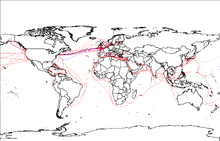
- An undersea communications cables to interconnect continents. There are two basic types of fiber optics, single-mode optical fiber (SMF) and multi-mode optical fiber (MMF). Single-mode fiber has the advantage of being able to sustain a coherent signal for dozens or even a hundred kilometers. Multimode fiber is cheaper to terminate but is limited to a few hundred or even only a few dozens of meters, depending on the data rate and cable grade.[35]
Wireless

Network connections can be established wirelessly using radio or other electromagnetic means of communication.
- Terrestrial microwave – Terrestrial microwave communication uses Earth-based transmitters and receivers resembling satellite dishes. Terrestrial microwaves are in the low gigahertz range, which limits all communications to line-of-sight. Relay stations are spaced approximately 40 miles (64 km) apart.
- Communications satellites – Satellites also communicate via microwave. The satellites are stationed in space, typically in geosynchronous orbit 35,400 km (22,000 mi) above the equator. These Earth-orbiting systems are capable of receiving and relaying voice, data, and TV signals.
- Cellular networks use several radio communications technologies. The systems divide the region covered into multiple geographic areas. Each area is served by a low-power transceiver.
- Radio and spread spectrum technologies – Wireless LANs use a high-frequency radio technology similar to digital cellular. Wireless LANs use spread spectrum technology to enable communication between multiple devices in a limited area. IEEE 802.11 defines a common flavor of open-standards wireless radio-wave technology known as Wi-Fi.
- Free-space optical communication uses visible or invisible light for communications. In most cases, line-of-sight propagation is used, which limits the physical positioning of communicating devices.
- Extending the Internet to interplanetary dimensions via radio waves and optical means, the Interplanetary Internet.[36]
The last two cases have a large
Network nodes
Apart from any physical transmission media, networks are built from additional basic system building blocks, such as network interface controllers, repeaters, hubs, bridges, switches, routers, modems, and firewalls. Any particular piece of equipment will frequently contain multiple building blocks and so may perform multiple functions.
Network interfaces

A network interface controller (NIC) is computer hardware that connects the computer to the network media and has the ability to process low-level network information. For example, the NIC may have a connector for plugging in a cable, or an aerial for wireless transmission and reception, and the associated circuitry.
In Ethernet networks, each NIC has a unique Media Access Control (MAC) address—usually stored in the controller's permanent memory. To avoid address conflicts between network devices, the Institute of Electrical and Electronics Engineers (IEEE) maintains and administers MAC address uniqueness. The size of an Ethernet MAC address is six octets. The three most significant octets are reserved to identify NIC manufacturers. These manufacturers, using only their assigned prefixes, uniquely assign the three least-significant octets of every Ethernet interface they produce.
Repeaters and hubs
A repeater is an electronic device that receives a network
Repeaters work on the physical layer of the OSI model but still require a small amount of time to regenerate the signal. This can cause a propagation delay that affects network performance and may affect proper function. As a result, many network architectures limit the number of repeaters used in a network, e.g., the Ethernet 5-4-3 rule.
An Ethernet repeater with multiple ports is known as an Ethernet hub. In addition to reconditioning and distributing network signals, a repeater hub assists with collision detection and fault isolation for the network. Hubs and repeaters in LANs have been largely obsoleted by modern network switches.
Bridges and switches
Network bridges and network switches are distinct from a hub in that they only forward frames to the ports involved in the communication whereas a hub forwards to all ports.[38] Bridges only have two ports but a switch can be thought of as a multi-port bridge. Switches normally have numerous ports, facilitating a star topology for devices, and for cascading additional switches.
Bridges and switches operate at the data link layer (layer 2) of the OSI model and bridge traffic between two or more network segments to form a single local network. Both are devices that forward frames of data between ports based on the destination MAC address in each frame.[39] They learn the association of physical ports to MAC addresses by examining the source addresses of received frames and only forward the frame when necessary. If an unknown destination MAC is targeted, the device broadcasts the request to all ports except the source, and discovers the location from the reply.
Bridges and switches divide the network's collision domain but maintain a single broadcast domain. Network segmentation through bridging and switching helps break down a large, congested network into an aggregation of smaller, more efficient networks.
Routers
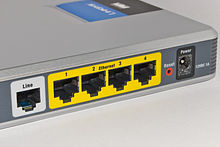
A router is an internetworking device that forwards packets between networks by processing the addressing or routing information included in the packet. The routing information is often processed in conjunction with the routing table. A router uses its routing table to determine where to forward packets and does not require broadcasting packets which is inefficient for very big networks.
Modems
Modems (modulator-demodulator) are used to connect network nodes via wire not originally designed for digital network traffic, or for wireless. To do this one or more
Firewalls

A firewall is a network device or software for controlling network security and access rules. Firewalls are inserted in connections between secure internal networks and potentially insecure external networks such as the Internet. Firewalls are typically configured to reject access requests from unrecognized sources while allowing actions from recognized ones. The vital role firewalls play in network security grows in parallel with the constant increase in cyber attacks.
Communication protocols


A
In a
There are many communication protocols, a few of which are described below.
Common protocols
Internet protocol suite
The
IEEE 802
IEEE 802 is a family of IEEE standards dealing with local area networks and metropolitan area networks. The complete IEEE 802 protocol suite provides a diverse set of networking capabilities. The protocols have a flat addressing scheme. They operate mostly at layers 1 and 2 of the OSI model.
For example,
Ethernet
Ethernet is a family of technologies used in wired LANs. It is described by a set of standards together called IEEE 802.3 published by the Institute of Electrical and Electronics Engineers.
Wireless LAN
Wireless LAN based on the IEEE 802.11 standards, also widely known as WLAN or WiFi, is probably the most well-known member of the IEEE 802 protocol family for home users today. IEEE 802.11 shares many properties with wired Ethernet.
SONET/SDH

Asynchronous Transfer Mode

Asynchronous Transfer Mode (ATM) is a switching technique for telecommunication networks. It uses asynchronous
ATM still plays a role in the last mile, which is the connection between an Internet service provider and the home user.[43][needs update]
Cellular standards
There are a number of different digital cellular standards, including:
Routing
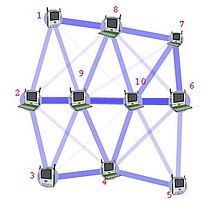
Routing is the process of selecting network paths to carry network traffic. Routing is performed for many kinds of networks, including circuit switching networks and packet switched networks.
In packet-switched networks, routing protocols direct packet forwarding through intermediate nodes. Intermediate nodes are typically network hardware devices such as routers, bridges, gateways, firewalls, or switches. General-purpose computers can also forward packets and perform routing, though because they lack specialized hardware, may offer limited performance. The routing process directs forwarding on the basis of routing tables, which maintain a record of the routes to various network destinations. Most routing algorithms use only one network path at a time. Multipath routing techniques enable the use of multiple alternative paths.
Routing can be contrasted with
Geographic scale
| Computer network types by scale |
|---|
 |
Networks may be characterized by many properties or features, such as physical capacity, organizational purpose, user authorization, access rights, and others. Another distinct classification method is that of the physical extent or geographic scale.
Nanoscale network
A
Personal area network
A
Local area network
A local area network (LAN) is a network that connects computers and devices in a limited geographical area such as a home, school, office building, or closely positioned group of buildings. Wired LANs are most commonly based on Ethernet technology. Other networking technologies such as ITU-T G.hn also provide a way to create a wired LAN using existing wiring, such as coaxial cables, telephone lines, and power lines.[47]
A LAN can be connected to a
Home area network
A
Storage area network
A storage area network (SAN) is a dedicated network that provides access to consolidated, block-level data storage. SANs are primarily used to make storage devices, such as disk arrays, tape libraries, and optical jukeboxes, accessible to servers so that the storage appears as locally attached devices to the operating system. A SAN typically has its own network of storage devices that are generally not accessible through the local area network by other devices. The cost and complexity of SANs dropped in the early 2000s to levels allowing wider adoption across both enterprise and small to medium-sized business environments.[citation needed]
Campus area network
A
For example, a university campus network is likely to link a variety of campus buildings to connect academic colleges or departments, the library, and student residence halls.
Backbone network
A
For example, a large company might implement a backbone network to connect departments that are located around the world. The equipment that ties together the departmental networks constitutes the network backbone. Another example of a backbone network is the Internet backbone, which is a massive, global system of fiber-optic cable and optical networking that carry the bulk of data between wide area networks (WANs), metro, regional, national and transoceanic networks.
Metropolitan area network
A metropolitan area network (MAN) is a large computer network that interconnects users with computer resources in a geographic region of the size of a metropolitan area.
Wide area network
A wide area network (WAN) is a computer network that covers a large geographic area such as a city, country, or spans even intercontinental distances. A WAN uses a communications channel that combines many types of media such as telephone lines, cables, and airwaves. A WAN often makes use of transmission facilities provided by common carriers, such as telephone companies. WAN technologies generally function at the lower three layers of the OSI model: the physical layer, the data link layer, and the network layer.
Enterprise private network
An
Virtual private network
A virtual private network (VPN) is an overlay network in which some of the links between nodes are carried by open connections or virtual circuits in some larger network (e.g., the Internet) instead of by physical wires. The data link layer protocols of the virtual network are said to be tunneled through the larger network. One common application is secure communications through the public Internet, but a VPN need not have explicit security features, such as authentication or content encryption. VPNs, for example, can be used to separate the traffic of different user communities over an underlying network with strong security features.
VPN may have best-effort performance or may have a defined service level agreement (SLA) between the VPN customer and the VPN service provider.
Global area network
A
Organizational scope
Networks are typically managed by the organizations that own them. Private enterprise networks may use a combination of intranets and extranets. They may also provide network access to the Internet, which has no single owner and permits virtually unlimited global connectivity.
Intranet
An intranet is a set of networks that are under the control of a single administrative entity. An intranet typically uses the Internet Protocol and IP-based tools such as web browsers and file transfer applications. The administrative entity limits the use of the intranet to its authorized users. Most commonly, an intranet is the internal LAN of an organization. A large intranet typically has at least one web server to provide users with organizational information.
Extranet
An extranet is a network that is under the administrative control of a single organization but supports a limited connection to a specific external network. For example, an organization may provide access to some aspects of its intranet to share data with its business partners or customers. These other entities are not necessarily trusted from a security standpoint. The network connection to an extranet is often, but not always, implemented via WAN technology.
Internet
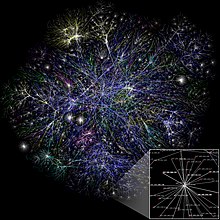
An
The
Participants on the Internet use a diverse array of methods of several hundred documented, and often standardized, protocols compatible with the Internet protocol suite and the IP addressing system administered by the Internet Assigned Numbers Authority and address registries. Service providers and large enterprises exchange information about the reachability of their address spaces through the Border Gateway Protocol (BGP), forming a redundant worldwide mesh of transmission paths.
Darknet
A darknet is an overlay network, typically running on the Internet, that is only accessible through specialized software. It is an anonymizing network where connections are made only between trusted peers — sometimes called friends (F2F)[51] — using non-standard protocols and ports.
Darknets are distinct from other distributed peer-to-peer networks as sharing is anonymous (that is, IP addresses are not publicly shared), and therefore users can communicate with little fear of governmental or corporate interference.[52]
Network service
Network services are applications hosted by servers on a computer network, to provide some functionality for members or users of the network, or to help the network itself to operate.
The
Services are usually based on a
Network performance
Bandwidth
Network delay
Network delay is a design and performance characteristic of a
- Processing delay – time it takes a router to process the packet header
- Queuing delay – time the packet spends in routing queues
- Transmission delay – time it takes to push the packet's bits onto the link
- Propagation delay – time for a signal to propagate through the media
A certain minimum level of delay is experienced by signals due to the time it takes to
Performance metrics
The parameters that affect performance typically can include
In circuit-switched networks, network performance is synonymous with the grade of service. The number of rejected calls is a measure of how well the network is performing under heavy traffic loads.[56] Other types of performance measures can include the level of noise and echo.
In an Asynchronous Transfer Mode (ATM) network, performance can be measured by line rate, quality of service (QoS), data throughput, connect time, stability, technology, modulation technique, and modem enhancements.[57][verification needed][full citation needed]
There are many ways to measure the performance of a network, as each network is different in nature and design. Performance can also be modeled instead of measured. For example, state transition diagrams are often used to model queuing performance in a circuit-switched network. The network planner uses these diagrams to analyze how the network performs in each state, ensuring that the network is optimally designed.[58]
Network congestion
Modern networks use
Another method to avoid the negative effects of network congestion is implementing quality of service priority schemes allowing selected traffic to bypass congestion. Priority schemes do not solve network congestion by themselves, but they help to alleviate the effects of congestion for critical services. A third method to avoid network congestion is the explicit allocation of network resources to specific flows. One example of this is the use of Contention-Free Transmission Opportunities (CFTXOPs) in the ITU-T G.hn home networking standard.
For the Internet,
Network resilience
Security
Computer networks are also used by security hackers to deploy computer viruses or computer worms on devices connected to the network, or to prevent these devices from accessing the network via a denial-of-service attack.
Network security
Network surveillance
Computer and network surveillance programs are widespread today, and almost all Internet traffic is or could potentially be monitored for clues to illegal activity.
Surveillance is very useful to governments and
However, many
End to end encryption
Examples of end-to-end encryption include
for radio.Typical
.The end-to-end encryption paradigm does not directly address risks at the endpoints of the communication themselves, such as the
SSL/TLS
The introduction and rapid growth of e-commerce on the World Wide Web in the mid-1990s made it obvious that some form of authentication and encryption was needed.
Views of networks
Users and network administrators typically have different views of their networks. Users can share printers and some servers from a
Network administrators can see networks from both physical and logical perspectives. The physical perspective involves geographic locations, physical cabling, and the network elements (e.g., routers, bridges and
Both users and administrators are aware, to varying extents, of the trust and scope characteristics of a network. Again using TCP/IP architectural terminology, an intranet is a community of interest under private administration usually by an enterprise, and is only accessible by authorized users (e.g. employees).[65] Intranets do not have to be connected to the Internet, but generally have a limited connection. An extranet is an extension of an intranet that allows secure communications to users outside of the intranet (e.g. business partners, customers).[65]
Unofficially, the Internet is the set of users, enterprises, and content providers that are interconnected by Internet Service Providers (ISP). From an engineering viewpoint, the Internet is the set of subnets, and aggregates of subnets, that share the registered
Over the Internet, there can be
Journals and newsletters
- Open Computer Science (open accessjournal)
See also
- Comparison of network diagram software
- Cyberspace
- History of the Internet
- Information Age
- Information revolution
- ISO/IEC 11801 – International standard for electrical and optical cables
- Minimum-Pairs Protocol
- Network simulation
- Network planning and design
- Network traffic control
- Cloud
- Network on a chip
References
- ISBN 978-1-85109-737-1.
- ISBN 978-0262542906.
- ISBN 978-3-486-85670-5.
- ISBN 978-0-262-03008-3. Archived(PDF) from the original on 2012-05-27. Retrieved 2020-05-26.
Shortly after the first paper on time-shared computers by C. Strachey at the June 1959 UNESCO Information Processing conference, H. M. Teager and J. McCarthy at MIT delivered an unpublished paper "Time-shared Program Testing" at the August 1959 ACM Meeting.
- ^ "Computer Pioneers - Christopher Strachey". history.computer.org. Archived from the original on 2019-05-15. Retrieved 2020-01-23.
- ^ "Reminiscences on the Theory of Time-Sharing". jmc.stanford.edu. Archived from the original on 2020-04-28. Retrieved 2020-01-23.
- ^ "Computer - Time-sharing and minicomputers". Encyclopedia Britannica. Archived from the original on 2015-01-02. Retrieved 2020-01-23.
- ISBN 978-0-19-286207-5.
- ^ Kitova, O. "Kitov Anatoliy Ivanovich. Russian Virtual Computer Museum". computer-museum.ru. Translated by Alexander Nitusov. Archived from the original on 2023-02-04. Retrieved 2021-10-11.
- ISBN 978-0262034180.
- ISBN 9781476708690. Archivedfrom the original on 2023-02-04. Retrieved 2021-06-04.
- ^ "NIHF Inductee Paul Baran, Who Invented Packet Switching". National Inventors Hall of Fame. Archived from the original on 2022-02-12. Retrieved 2022-02-12.
- ^ "NIHF Inductee Donald Davies, Who Invented Packet Switching". National Inventors Hall of Fame. Archived from the original on 2022-02-12. Retrieved 2022-02-12.
- ^ (PDF) from the original on 2023-02-04. Retrieved 2022-02-12.
Both Paul Baran and Donald Davies in their original papers anticipated the use of T1 trunks
- S2CID 8172150.
Transmission of packets of data over the high-speed lines
- from the original on 2020-01-01. Retrieved 2020-07-31.
This was the first digital local network in the world to use packet switching and high-speed links.
- UCLA. Archived from the originalon 2008-03-08.
- ISBN 0192862073.
- ISBN 9781135455514. Archivedfrom the original on 2023-02-04. Retrieved 2017-10-01.
- ^ Alarcia, G.; Herrera, S. (1974). "C.T.N.E.'s PACKET SWITCHING NETWORK. ITS APPLICATIONS". Proceedings of 2nd ICCC 74. pp. 163–170. Archived from the original on 2021-04-14.
- ^ Cuenca, L. (1980). "A public packet switching data communications network: eight years of operating experience". Conference Record of ICC 80. IEEE. pp. 39.3.1–39.3.5. Archived from the original on 2021-04-14.
- ^ Lavandera, Luis (1980). "ARCHITECTURE, PROTOCOLS AND PERFORMANCE OF RETD". Conference Record of ICC 80. IEEE. pp. 28.4.1–28.4.5. Archived from the original on 2021-04-14.
- ISBN 978-0-309-17414-5. Archived from the original on 2023-02-04. Retrieved 2021-03-08.)
{{cite book}}: CS1 maint: multiple names: authors list (link) CS1 maint: numeric names: authors list (link - ^ Bennett, Richard (September 2009). "Designed for Change: End-to-End Arguments, Internet Innovation, and the Net Neutrality Debate" (PDF). Information Technology and Innovation Foundation. p. 11. Archived from the original (PDF) on 2019-08-29. Retrieved 2017-09-11.
- S2CID 1558618.
- S2CID 34735326.
- S2CID 429216.
- .
- ^ Pelkey, James L. (2007). "6.9 – Metcalfe Joins the Systems Development Division of Xerox 1975-1978". Entrepreneurial Capitalism and Innovation: A History of Computer Communications, 1968-1988. Archived from the original on 2023-02-04. Retrieved 2019-09-05.
- ^ ISBN 1-56592-660-9.
- ^ "Introduction to Ethernet Technologies". www.wband.com. WideBand Products. Archived from the original on 2018-04-10. Retrieved 2018-04-09.
- ^ Pelkey, James L. (2007). "Yogen Dalal". Entrepreneurial Capitalism and Innovation: A History of Computer Communications, 1968-1988. Retrieved 2023-05-07.
- ^ a b D. Andersen; H. Balakrishnan; M. Kaashoek; R. Morris (October 2001), Resilient Overlay Networks, Association for Computing Machinery, archived from the original on 2011-11-24, retrieved 2011-11-12
- ^ "End System Multicast". project web site. Carnegie Mellon University. Archived from the original on 2005-02-21. Retrieved 2013-05-25.
- ^ OCLC 748332969.
- ^ A. Hooke (September 2000), Interplanetary Internet (PDF), Third Annual International Symposium on Advanced Radio Technologies, archived from the original (PDF) on 2012-01-13, retrieved 2011-11-12
- ^ "Bergen Linux User Group's CPIP Implementation". Blug.linux.no. Archived from the original on 2014-02-15. Retrieved 2014-03-01.
- ^ Bradley Mitchell. "bridge – network bridges". About.com. Archived from the original on 2008-03-28.
- ^ "Define switch". webopedia. September 1996. Archived from the original on 2008-04-08. Retrieved 2008-04-08.
- ^ Tanenbaum, Andrew S. (2003). Computer Networks (4th ed.). Prentice Hall.
- ISBN 978-1-5044-6440-6. Archivedfrom the original on 2023-02-04. Retrieved 2022-05-09.
- ISBN 978-1-5044-7283-8. Archivedfrom the original on 2022-05-17. Retrieved 2022-05-09.
- ^ Martin, Thomas. "Design Principles for DSL-Based Access Solutions" (PDF). Archived from the original (PDF) on 2011-07-22.
- ISBN 978-0-8900-6688-1.
- ISBN 978-1-60807-003-9.
- ^ Margaret Rouse. "personal area network (PAN)". TechTarget. Archived from the original on 2023-02-04. Retrieved 2011-01-29.
- ITU. 2008-12-12. Archived from the originalon 2009-02-21. Retrieved 2011-11-12.
- ^ "IEEE P802.3ba 40Gb/s and 100Gb/s Ethernet Task Force". IEEE 802.3 ETHERNET WORKING GROUP. Archived from the original on 2011-11-20. Retrieved 2011-11-12.
- ^ "IEEE 802.20 Mission and Project Scope". IEEE 802.20 — Mobile Broadband Wireless Access (MBWA). Retrieved 2011-11-12.
- ^ "Maps". The Opto Project. Archived from the original on 2005-01-15.
- .
- ^ Wood, Jessica (2010). "The Darknet: A Digital Copyright Revolution" (PDF). Richmond Journal of Law and Technology. 16 (4). Archived (PDF) from the original on 2012-04-15. Retrieved 2011-10-25.
- .
- .
- ISBN 978-0-1238-5060-7.
- ^ ITU-D Study Group 2 (June 2006). Teletraffic Engineering Handbook (PDF). Archived from the original (PDF) on 2007-01-11.
{{cite book}}: CS1 maint: numeric names: authors list (link) - ^ "Telecommunications Magazine Online". January 2003. Archived from the original on 2011-02-08.
- ^ "State Transition Diagrams". Archived from the original on 2003-10-15. Retrieved 2003-07-13.
- ^ "Definitions: Resilience". ResiliNets Research Initiative. Archived from the original on 2020-11-06. Retrieved 2011-11-12.
- S2CID 2204780.
- ^ a b "Is the U.S. Turning Into a Surveillance Society?". American Civil Liberties Union. Archived from the original on 2017-03-14. Retrieved 2009-03-13.
- ^ Jay Stanley; Barry Steinhardt (January 2003). "Bigger Monster, Weaker Chains: The Growth of an American Surveillance Society" (PDF). American Civil Liberties Union. Archived (PDF) from the original on 2022-10-09. Retrieved 2009-03-13.
- ^ Emil Protalinski (2012-04-07). "Anonymous hacks UK government sites over 'draconian surveillance'". ZDNet. Archived from the original on 2013-04-03. Retrieved 12 March 2013.
- ^ James Ball (2012-04-20). "Hacktivists in the frontline battle for the internet". The Guardian. Archived from the original on 2018-03-14. Retrieved 2012-06-17.
- ^ .
![]() This article incorporates public domain material from Federal Standard 1037C. General Services Administration. Archived from the original on 2022-01-22.
This article incorporates public domain material from Federal Standard 1037C. General Services Administration. Archived from the original on 2022-01-22.
Further reading
- Shelly, Gary, et al. "Discovering Computers" 2003 Edition.
- Wendell Odom, Rus Healy, Denise Donohue. (2010) CCIE Routing and Switching. Indianapolis, IN: Cisco Press
- Kurose James F and Keith W. Ross: Computer Networking: A Top-Down Approach Featuring the Internet, Pearson Education 2005.
- William Stallings, Computer Networking with Internet Protocols and Technology, Pearson Education 2004.
- Important publications in computer networks
- Network Communication Architecture and Protocols: OSI Network Architecture 7 Layers Model
- Robert Gallager, "Data Networks," Prentice Hall, 1992.

